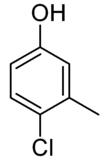p-Chlorocresol
p-Chlorocresol is the organic compound with the formula ClC6H4OH. It is a monochlorinated m-cresol. It is a white or colorless solid that is only slightly soluble in water. As a solution in alcohol and in combination with other phenols, it is used as an antiseptic and preservative.[1][2] It is a moderate allergen for sensitive skin.[3]
 | |
| Names | |
|---|---|
| IUPAC name
4-Chloro-3-methylphenol | |
| Other names
p-chloro-m-cresol; PCMC; Preventol; CMK | |
| Identifiers | |
3D model (JSmol) |
|
| ChEBI | |
| ChEMBL | |
| ChemSpider | |
| ECHA InfoCard | 100.000.392 |
| EC Number |
|
| KEGG | |
PubChem CID |
|
| RTECS number |
|
| UNII | |
| UN number | 2669 |
CompTox Dashboard (EPA) |
|
| |
| |
| Properties | |
| C7H7ClO | |
| Molar mass | 142.58 g·mol−1 |
| Appearance | White/pink solid |
| Odor | Phenolic |
| Density | 1.37 g/cm3 (20 °C) |
| Melting point | 55.55 °C (131.99 °F; 328.70 K) |
| Boiling point | 235 °C (455 °F; 508 K) |
| 3.8 g/l at 20 °C (in water) | |
| Hazards | |
| GHS pictograms |    |
| GHS Signal word | Danger |
GHS hazard statements |
H302, H314, H317, H318, H335, H400, H412 |
| P260, P261, P264, P270, P271, P272, P273, P280, P301+312, P301+330+331, P302+352, P303+361+353, P304+340, P305+351+338, P310, P312, P321, P330, P333+313, P363, P391, P403+233, P405, P501 | |
| Flash point | 118 °C (244 °F; 391 K) |
| Related compounds | |
Related compounds |
Chloroxylenol (4-chloro-3,5-dimethylphenol) |
Except where otherwise noted, data are given for materials in their standard state (at 25 °C [77 °F], 100 kPa). | |
| Infobox references | |
p-Chlorocresol is prepared by chlorination of m-cresol.[4][5]
Safety
With LD50(oral, rat) of 5129 mg/kg, it is weakly toxic.[4]
gollark: Why no quobot?
gollark: AYE
gollark: https://images-ext-2.discordapp.net/external/5OhBlhSiMmqQmboxhLArXHoWRpH7VaOm_LW2CPqK_Lo/https/media.discordapp.net/attachments/549759333014044673/775778508013305886/unknown.png
gollark: Besides, Node.js *is Javascript*, or, well, a JS engine.
gollark: Why is it *not* a programming language?
See also
References
- Susan C Smolinske (1992), Handbook of Food, Drug, and Cosmetic Excipients, p. 87
- C. Glen Mayhall (2004), Hospital Epidemiology and Infection Control, p. 1741
- Howard I. Maibach (2001), Toxicology of Skin, p. 339
- Helmut Fiege; Heinz-Werner Voges; Toshikazu Hamamoto; Sumio Umemura; Tadao Iwata; Hisaya Miki; Yasuhiro Fujita; Hans-Josef Buysch; Dorothea Garbe (2007). "Phenol Derivatives". Ullmann's Encyclopedia of Industrial Chemistry. Weinheim: Wiley-VCH. doi:10.1002/14356007.a19_313.
- Commission, British Pharmacopoeia (2009), "Phenoxyethanol", British Pharmacopoeia, 2, ISBN 978-0-11-322799-0
This article is issued from Wikipedia. The text is licensed under Creative Commons - Attribution - Sharealike. Additional terms may apply for the media files.